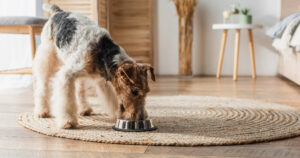Dogs come in all shapes and sizes, and one of the most distinguishing features between breeds is the length and shape of their snouts.

Long-nosed dog breeds, also known as dolichocephalic dogs, have more space in their nasal cavities for olfactory receptors, giving them an excellent sense of smell.
These dogs often have lean heads and aerodynamic features that aid them in hunting and tracking.
What is a Long Snout?
A dog’s snout consists of the upper and lower jaw, containing structures like the nose, mouth, and teeth. Long snouts are classified based on having an elongated length compared to the skull region. They also tend to have a narrower width.
Specific characteristics include:
- Much longer than the skull region of the head
- Accounts for a significant portion of overall head length
- Often narrower in width compared to shorter snouts
- Slim, aerodynamic shape
Veterinarians use a measurement called the cephalic index to categorize head shapes. Dogs with an index lower than 75 are considered long-snouted or dolichocephalic.
Key Takeaway: A long snout is classified as being significantly longer than the skull and having a slimmer width compared to shorter, stockier muzzles.
The History and Purpose of Long Snouts
So why did certain breeds develop those distinctive lengthy muzzles? Long snouts served important functional purposes for the roles these dogs were originally bred to fulfill.
Hunting dogs like Greyhounds and Salukis used their long noses and lean heads to sniff out and chase prey across long distances. Their aerodynamic shapes supported their speed and endurance.
Sporting dogs such as Whippets and Borzois needed elongated muzzles to breathe easily while running and racing. Their long heads reduced wind resistance for lightning-fast movement.
Herding breeds like Collies utilized their lengthy snouts to nip at livestock and direct their movement. Their narrow mouths allowed for controlled and precise biting.
Hounds were able to pick up scents from far away thanks to ample space for olfactory receptors. Additional skin and wrinkles around their faces helped trap odors near their noses.
So in many cases, these dogs’ defining long snouts served crucial functions to aid them in their duties. Form followed function in the development of these breeds.
Advantages of Long Snouts
The elongated muzzles of these dogs provide some key advantages:
- Enhanced breathing – Longer air passages facilitate easier breathing, especially during physical exertion. This supports better thermoregulation.
- Keener sense of smell – More area in the nasal cavity means more scent receptors, improving sniffing abilities. Great for tracking.
- Aerodynamic shape – A lean, narrow head reduces drag and wind resistance for hunting, racing, and agility.
- Precise biting – A longer, slimmer muzzle allows for controlled nibbling and gripping. Helpful during herding.
- Efficient panting – Longer snouts provide more surface area for evaporative cooling through panting, preventing overheating.
So while an extended snout has a clear functional purpose, it also confers some advantages that benefit the dog beyond their original duties. Those amplified scenting abilities, for example, can make them excellent search and rescue or drug detection dogs.
Potential Drawbacks of Lengthy Snouts
That said, elongated muzzles can come with some drawbacks to be aware of:
- Injury risk – A longer snout has more area that can potentially be hurt during work. Especially true for active hunting breeds.
- Dental issues – Crowded, misaligned teeth are more common with lengthy narrow jaws. Proper dental care is a must.
- Sensitive snout – More surface area means more opportunity for cuts, abrasions, or sunburn. Dogs may need snout balms or sunscreen.
- Dry nose – With greater surface area, moisture is more apt to evaporate from the nose. Snout hydration is important.
- Picky eating – Some long snout breeds are fussier eaters, possibly due to a reduced sense of smell. Finding foods they enjoy can take trial and error.
While not universal downsides, prospective owners of long-muzzled breeds should be prepared to take steps to prevent or manage these potential issues. Proper care helps ensure their lovely lengthy snouts remain healthy.
Popular Long Snout Dog Breeds
Now that we’ve covered the background of these distinctive dolichocephalic dogs, let’s look at some of the most popular long snout breeds:
Afghan Hound
The Afghan Hound is instantly recognizable thanks to its aristocratic appearance and glamorous silky coat. Their long, narrow heads taper gently to a slender muzzle. While initially hunting dogs, today Afghan Hounds thrive as companions and canine athletes.
Key traits:
- Luxurious long coat
- Proud, dignified demeanor
- Independent personality
- Height: 25-27 inches
Saluki
As one of the oldest domesticated dog breeds, the Saluki has an elegant appearance echoed in its long, chiselled head. Originally Middle Eastern hunting dogs, Salukis are built for speed and athleticism. Their affectionate nature also makes them loving family members.
Key traits:
- Streamlined and graceful build
- Quietly devoted to their people
- Need regular opportunity to run
- Height: 23-28 inches
Greyhound
The slender Greyhound is built for speed, with a long, narrow head tapering to a lengthy muzzle. Bred as racing and hunting dogs, Greyhounds retain a strong prey drive but thrive as mellow pets when exercised regularly. Their minimal coat requires protection from temperature extremes.
Key traits:
- Reach speeds up to 45mph
- Gentle, noble temperament
- Prone to chills without a coat
- Height: 27-30 inches
Borzoi
This Russian sighthound has a distinctly narrow, elongated head that extends into a tapered snout. Originally used to hunt wolves and foxes, the graceful Borzoi retains strong chase instincts today. Borzois bond deeply with their families.
Key traits:
- Silky, wavy coat
- Independent yet loyal
- Sight chase drive remains
- Height: 26-28 inches
Whippet
Often described as a “small Greyhound,” Whippets share their cousins’ lean physique and lengthy muzzle. Bred for racing and hunting rabbits, they’re true sprinters at heart. Their affectionate nature makes them excellent house pets.
Key traits:
- Streamlined, slender build
- Gentle and calm indoors
- Thrive on sprints and chases
- Height: 18-22 inches
Basenji
The Basenji originated as a hunting dog in central Africa, using its petite body and elongated muzzle to chase small game. Though independent, Basenjis bond closely with their families. Yodel-like vocalizations are a signature trait.
Key traits:
- Curly tail
- Reserved with strangers
- Yodel instead of bark
- Height: 16-17 inches
Collies
The elegant Collie comes in both rough and smooth coated varieties, but both sport a distinctive narrow snout. Bred as herding dogs, Collies are highly intelligent, eager to please, and loyal. They make wonderful active family companions.
Key traits:
- Profuse coat (rough variety)
- Exceptionally smart and trainable
- Devoted to family
- Height: 22-26 inches
Dachshund
The famously long, low Dachshund comes in miniature to standard sizes, but all have an elongated snout. Originally bred to hunt badgers and other burrow-dwelling prey, Dachshunds retain their bold hunting spirit in a small package.
Key traits:
- Distinctively long, low body
- Spunky, tenacious personality
- Loud, baying bark
- Height: 5-9 inches
Bull Terrier
Though stocky in build, the Bull Terrier’s long, egg-shaped head ends in a tapering triangular muzzle. Developed originally for vermin hunting and dog fighting, today’s Bull Terriers are affectionate and comical companions.
Key traits:
- Oblong-shaped head
- Clownish, mischievous nature
- Muscular, stocky build
- Height: 21-22 inches
Caring for Long Snout Dog Breeds
While long-muzzled dogs span a range of shapes, sizes, and backgrounds, some general care considerations apply to these breeds:
- Dental care – Brush frequently and provide chews to combat potential dental crowding.
- Snout protection – Use dog-safe sunscreen and balms to protect their elegant snouts from damage.
- Proper fencing – Strong enclosures allow them to run safely, preventing wandering when chasing scents or prey.
- Mental stimulation – Clever activities and puzzles will satisfy their active minds.
- Socialization – Training classes and carefully managed introductions can build their confidence.
- Patience – Work through any potential stubbornness or aloofness with kind consistency.
- Picky eating – Experiment with different foods and adding mix-ins to tempt disinterested eaters.
With thoughtful care tailored to their needs, a long-nosed dog can thrive as a wonderful four-legged family member.
Choosing a Long Snout Breed
If you’re considering a long-muzzled dog for your next canine companion, reflect on these key questions:
- Is the breed’s activity level a match for your lifestyle? These dogs often need plenty of exercise.
- Can you provide the space for them to run safely off-leash? Fenced areas are ideal.
- Are you prepared to socialize and train? Their intelligence demands mental stimulation.
- Does your climate suit the breed? Some do better in temperate areas.
- Are you able to groom requirements like daily brushing for heavy coats?
- Will the breed integrate well with any current pets? Look for low prey drive.
Matching an energetic, intelligent long-nosed dog with an active home life, proper training, and safe spaces to run sets everyone up for happiness.
FAQs
Why do some dogs have such long noses?
Long snouts evolved in many dogs to enhance scenting, provide aerodynamic shape, and enable precise biting. The structure served specific functions for hunting, herding, racing, and other duties. Form follows function in these breeds.
What’s the advantage of a longer nose?
A lengthy snout improves breathing, olfaction, panting, and wind resistance. More space in the nasal passages and sinuses accommodates these functions. The trade-off is reduced bite strength.
Do long noses mean better sniffers?
Yes, all else being equal. More area devoted to olfactory tissue and longer air passages means more scent particles can bind. It improves ability to detect and follow scents.
Are these dogs faster than short-nosed breeds?
Often, yes. Dogs like Greyhounds and Whippets have lean heads that reduce drag. Combined with light, aerodynamic bodies, they can achieve incredible speeds for short bursts.
Do long snouts cause health issues?
Potentially. They are more prone to some dental overcrowding, nose/mouth injuries, and sunburn. However, they have fewer breathing issues than short-nosed (brachycephalic) breeds.
Conclusion
The dolichocephalic head shape is a defining trait of many classic dog breeds. Initially serving hunting, herding, racing, and tracking functions, those lean, lengthy muzzles conferred key sensory advantages.
Today, we prize these dogs not just for their graceful appearance, but as companions and athletes who integrate into family life. With nurturing homes, attentive care, training, and safe spaces to run, these proud long-snouted breeds can flourish inside or outside the field.







